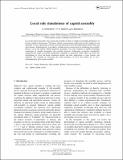Local Rule Simulations of Capsid Assembly
Author(s)
Schwartz, R.; Shor, Peter W.; Berger, Bonnie
DownloadCMMM.2005.310978.pdf (212.2Kb)
PUBLISHER_CC
Publisher with Creative Commons License
Creative Commons Attribution
Terms of use
Metadata
Show full item recordAbstract
Local rules theory describes virus capsid self-assembly in terms of simple local binding preferences of discrete subunit conformations. The theory offered a parsimonious explanation for the complexity and regularity of virus capsids that resolved several inconsistencies between experimental observations and prior theories. Simultaneously, it provided a valuable practical abstraction for simulating the assembly process. Local rule models offered important advantages over other methods in rapidly developing simulations of complex geometries and assembly processes. Subsequent extensions considerably augmented the range of assembly phenomena amenable to simulation studies. Here we review the development of local rule-based simulation models and their applications to basic biology and medicine. We conclude by discussing the future prospects of local rule models for in silico experimentation with capsid assembly.
Date issued
2005-06Department
Massachusetts Institute of Technology. Computer Science and Artificial Intelligence Laboratory; Massachusetts Institute of Technology. Department of MathematicsJournal
Journal of Theoretical Medicine
Publisher
Hindawi Publishing Corporation
Citation
Schwartz, R., P. W. Shor, and B. Berger. “Local Rule Simulations of Capsid Assembly.” Journal of Theoretical Medicine 6, no. 2 (2005): 81–85. © 2005 Hindawi Publishing Corporation
Version: Final published version
ISSN
1027-3662
1607-8578